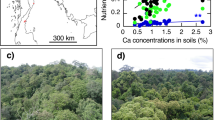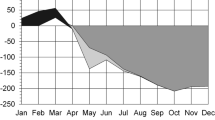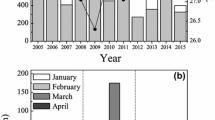Abstract
In the present study phenological activities such as leaf and shoot growth, leaf pool size and leaf fall were observed for 3 years (March 2007–March 2010) in 19 tree species (13 evergreen and 6 deciduous species) in a wet tropical forest in Assam, India. The study area receives total annual average rainfall of 2,318 mm of which most rain fall (>70 %) occurs during June–September. Both the plant groups varied significantly on most of the shoot and leaf phenology parameters. In general, growth in deciduous species initiated before the evergreen species and showed a rapid shoot growth, leaf recruitment and leaf expansion compared to evergreen species. Leaf recruitment period was significantly different between evergreen (4.2 months) and deciduous species (6.8 months). Shoot elongation rate was also significantly different for evergreen and deciduous species (0.09 vs. 0.14 cm day−1 shoot−1). Leaf number per shoot was greater for deciduous species than for evergreen species (34 vs. 16 leaves). The average leaf life span of evergreen species (328 ± 32 days) was significantly greater than that of deciduous species (205 ± 16 days). The leaf fall in deciduous species was concentrated during the winter season (Nov–Feb), whereas evergreens retained their leaves until the next growing season. Although the climate of the study area supports evergreen forests, the strategies of the deciduous species such as faster leaf recruitment rate, longer leaf recruitment time, faster shoot elongation rate during favorable growing season and short leaf life span perhaps allows them to coexist with evergreen species that have the liberty to photosynthesize round the year. Variations in phenological strategies perhaps help to reduce the competition among evergreen and deciduous species for resources in these forests and enable the coexistence of both the groups.






Similar content being viewed by others
References
Anderson JM, Ingram JSI (1993) Tropical soil biology and fertility: a hand book of methods. CAB International, UK
Arroyo MTK, Armesto JZ, Villagran C (1981) Plant phenological patterns in the high Andean Cordillera of Central Chile. J Ecol 69:205–223
Bhat DM (1992) Phenology of tree species of tropical moist forest of Uttara Kannada district, Karnataka, India. Bioscience 17:325–352
Boojh R, Ramakrishnan PS (1981) Phenology of trees in a sub-tropical evergreen mountain forest in north-east India. Geol Ecol Trop 5:189–209
Borah N, Garkoti SC (2011) Tree Species composition, diversity, and regeneration patterns in undisturbed and disturbed forests of Barak Valley, South Assam, India. Int J Ecol Environ Sci 37:131–141
Borah N, Garkoti SC (2012) Community structure and diversity of tropical forests along with disturbance gradients in Barak Valley of Assam, India. Assam Univ J Sci Technol 37:131–141
Borchert R (1994) Water storage in soil or tree stems determines phenology and distribution of tropical dry forest trees. Ecology 75:1437–1449
Borchert R, Rivera G (2001) Photoperiodic control of seasonal development and dormancy in tropical stem-succulent trees. Tree Physiol 21:213–221
Borchert R, Rivera G, Hagnauer W (2002) Modification of vegetative phenology in a tropical semi deciduous forest by abnormal drought and rain. Biotropica 34:27–29
Dhaila S, Singh SP, Negi GCS, Rawat YS (1995) Shoot growth phenology of co-existing evergreen and deciduous species in an oak forest. Ecol Res 10:151–159
Diez JM, Inbenz I, Miller Rushing AJ, Mazer SJ, Crimmins TM, Crimmins MA, Bertelsen CD, Inouye DW (2012) Forecasting phenology: from species variability to community patterns. Ecol Lett. doi:10.1111/j.146-0248
Elliott S, Baker PJ, Borchert R (2006) Leaf flushing during the dry season: the paradox of Asian monsoon forests. Glob Ecol Biogeogr 15:248–257
Frankie GW, Baker HG, Opler PA (1974) Comparative phenological studies of trees in tropical wet and dry forest in the lowlands of Costa Rica. J Ecol 62:881–913
Garkoti SC, Singh SP (1994) Nutrient cycling in the three central Himalayan forests ranging from close canopied to open canopied treeline forests, India. Arct Alp Res 26:339–348
Garkoti SC, Singh SP (1995) Variation in forest biomass and net primary productivity in the high mountains of Central Himalaya. J Veg Sci 6:23–28
Garkoti SC, Zobel DB, Singh SP (2003) Variation in drought response of Sal (Shorea robusta) seedlings. Tree Physiol 23:1021–1030
Givnish TJ (1984) Leaf and canopy adaptation in tropical forests. In: Medina B, Mooney HA, Vasquez-Yanes (eds) Physiological ecology of plants of the wet tropics. Dr. W. Junk. The Hague, pp 51–84
Givnish TJ (1987) Comparative studies of leaf form: assessing the relative roles of selective pressures and phylogenetic constraints. New Phytol 106:131–160
Gray JT (1982) Community structure and productivity in Coenothus chaparral and coastal sage scrub of southern California. Ecol Monogr 52:415–435
Grime JP (1994) The role of plasticity in exploiting environmental heterogeneity. In: Caldwell MM, Pearcy RW (eds) Exploitation of environmental heterogeneity by plants. Academic Press, New York, pp 1–21
Hallik L, Niinemets U, Wright IJ (2009) Are species shade and drought tolerance reflected in leaf-level structural and functional differentiation in Northern Hemisphere temperate woody flora? New Phytol 184:257–274
Hegland SJ, Nielsen A, Lazaro A, Bjerknes AI, Totland O (2009) How does climate warming affect plant-pollinator interactions. Ecol Lett 12:184–195
Kikim A, Yadava PS (2001) Phenology of tree species in subtropical forest of Manipur in northeastern India. Trop Ecol 42:269–276
Kikuzawa K (1989) Ecology and evolution of phenological pattern, leaf longevity and leaf habit. Evol Trend Plant 3:105–110
Kikuzawa K (2003) Phenological and morphological adaptations to the light environment in two woody and two herbaceous plant species. Funct Ecol 17:29–38
Kikuzawa K, Lechowicz MJ (2011) Ecology of leaf longevity. Ecol Res Monogr. Springer, Berlin
Kikuzawa K, Koyoma H, Umeki K, Lechowicz MJ (1996) Some evidence for an adaptive linkage between leaf phenology and shoot architecture in sampling trees. Funct Ecol 10:252–257
Kushwaha CP, Singh KP (2005) Diversity of leaf phenology in a tropical deciduous forest in India. J Trop Ecol 21:47–56
Marques MCM, Roper JJ, Salvalaggio APB (2004) Phenological patterns among plant life-form in a subtropical forest in southern Brazil. Plant Ecol 173:203–213
Miller-Rushing AJ, Inouye DW (2009) Variation in the impact of climate change on flowering phenology and abundance: an examination of two pairs of closely related wild flower species. Am J Bot 96:1821–1829
Miyazawa Y, Kikuzawa K (2004) Phenology and photosynthetic traits of short shoots and long shoots in Betula grossa. Tree Physiol 24:631–637
Mooney HA, Dunn DL (1970) Convergent evolution of Mediterranean-climate evergreen sclerophyll shrubs. Evolution 24:292–303
Negi GCS (2006) Leaf and bud demography and shoot growth in evergreen and deciduous trees of central Himalaya, India. Tree 20:416–429
Negi GCS, Singh SP (1992) Leaf growth pattern in evergreen and deciduous species of the Central Himalaya, India. Int J Biometeorol 36:233–242
Opler PA, Frankie GW, Baker HG (1976) Rainfall as a factor in the release, timing and synchronization of anthesis by tropical trees and shrubs. J Biogeogr 3:231–236
Ralhan PK, Khanna RK, Singh SP, Singh JS (1985a) Phenological characters of the tree layer of Kumaun Himalayan forests. Vegetatio 60:91–101
Ralhan PK, Khanna RK, Singh SP, Singh JS (1985b) Certain phenological characters of the shrub layer of Kumaun Himalayan forests. Vegetatio 63:113–120
Raunkiaer C (1934) The life forms of plants and Statistical plant geography. Clarendon, London
Reich PB (1994) Phenology of tropical forest: patterns, causes and consequences. Can J Bot 73:164–174
Reich PB, Borchert R (1982) Phenology and ecophysiology of the tropical tree Tabebuia neochrysantha (Bignoniaceae). Ecology 63:294–299
Reich PB, Uhl C, Walters MB, Prugh L, Ellsworth DS (2004) Leaf demography and phenology in Amazonian rain forest: a census of 40000 leaves of 23 tree species. Ecol Monogr 74:3–23
Richardson A, Andy Black T, Ciais P, Delbart N, Friedl M, et al (2010) Influence of spring and autumn phonological transitions on forest ecosystem productivity. Phil Trans R Soc B Biol Sci 365:3227
Rivera G, Elliott S, Caldas LS, Nicolossi G, Coradin VTR, Borchert R (2002) Increasing day length induces spring flushing of tropical dry forest trees in the absence of rain. Tree 16:445–456
Shukla RP, Ramakrishnan PS (1982) Phenology of trees in a subtropical humid forest in north eastern India. Vegetatio 49:103–109
Singh JS, Singh SP (1992) Forests of Himalaya. Structure, functioning and impact of man. Gyanodaya Prakashan, Nainital
Singh SP, Ralhan PK, Upadhyay VP, Negi GCS (1990) Seasonal changes in stem diameter and leaf development in a tropical montane forest. J Veg Sci 1:165–172
Singh SP, Zobel DB, Garkoti SC, Tewari A, Negi CMS (2006) Patterns in water relations of central Himalayan trees. Trop Ecol 47:159–182
Sundriyal RC (1990) Phenology of some temperate woody species of the Garhwal Himalaya. Int J Ecol Environ Sci 6:107–117
Walter H (1971) Ecology of tropical and subtropical vegetation. Oliver and Boyd, Edinburgh
Westoby M, Falster DS, Moles AT, Vesk PA, Wright IJ (2002) Plant ecological strategies: some leading dimensions of variation between species. Annu Rev Ecol Evol Syst 33:1125–1159
Wright SJ, van Schaik CP (1994) Light and the phenology of tropical trees. Am Nat 143:192–199
Yadav RK, Yadav AS (2008) Phenology of selected woody species in a tropical dry deciduous forest in Rajasthan, India. Trop Ecol 49:25–34
Acknowledgments
The authors are thankful to Dr. GCS Negi for reading the first draft of the manuscript. We also thank two anonymous reviewers for their helpful comments.
Author information
Authors and Affiliations
Corresponding author
Additional information
Communicated by E. Beck.
Appendices
Appendix 1
See Table 4.
Appendix 2
See Table 5.
Rights and permissions
About this article
Cite this article
Devi, A.F., Garkoti, S.C. Variation in evergreen and deciduous species leaf phenology in Assam, India. Trees 27, 985–997 (2013). https://doi.org/10.1007/s00468-013-0850-8
Received:
Revised:
Accepted:
Published:
Issue Date:
DOI: https://doi.org/10.1007/s00468-013-0850-8




